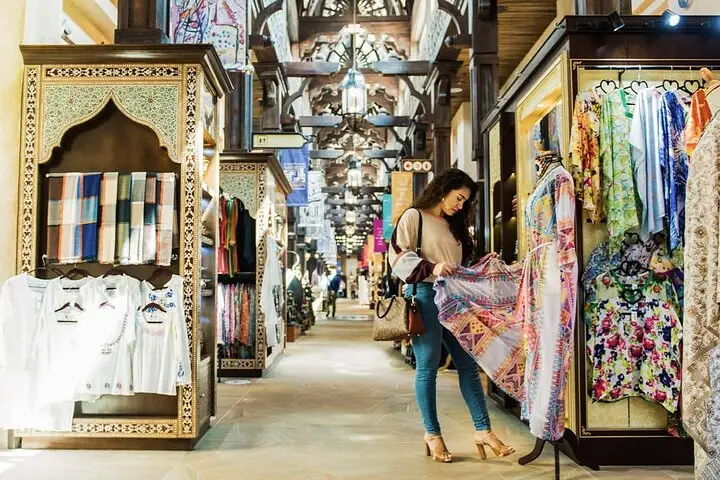Forget your usual ideas about shopping centers. In Dubai, a megamall is not just a store, but something grandiose. Imagine: 1.2 million square meters, over 1200 boutiques, and a whole range of emotions — from Tiffany to Carrefour. Dubai Mall is the flagship of Dubai retail, attracting 75 million visitors annually, and its significance cannot be overstated. That’s why many people ask the question, “What to buy at Dubai Mall?” We will tell you what interesting things you can find and purchase.
Brands at Dubai Mall
Fashion Avenue is the epicenter of luxury shopping and the main attraction for high fashion enthusiasts. Here you will find flagship boutiques such as Chanel, Dior, Valentino, Louis Vuitton, Bottega Veneta. The runway starts right at the entrance: glass showcases, soft lighting, personalized approach.

The Gucci boutique showcases not just collections, but new forms of architecture. Prada uses space as an art gallery. Brands set standards not only for clothing but also for consumption. Fashion Avenue constantly updates its lines and holds private shows for high-status clients.
What to buy at Dubai Mall in this area is obvious. Everything that falls into the luxury category: from couture coats to limited edition accessories with serial numbers.
Electronics and Technology
The electronics sector at Dubai Mall offers not just an assortment, but an insight into the future. The flagship Sharaf DG showcases a full range of innovations from Apple, Samsung, Dyson, Sony. Models that have not yet reached regular stores are on display, including concepts from technology shows.
Sony presents OLED TVs with built-in sound, Apple offers the full range of MacBook Pro M-series, Samsung showcases foldable smartphones and flagship tablets. Electronics attract enthusiasts and collectors. Prices vary: the latest generation laptop starts from 4000 AED, flagship smartphone from 3000 AED.
What to buy at Dubai Mall in terms of technology depends on preferences. Here you can find high-end gadgets as well as practical models for tourists looking to save at duty-free.
Jewelry, Watches, and Timepieces
Jewelry galleries occupy strategic points near entrances and elevators. Cartier, Piaget, Bvlgari, Chopard, Graff are not just brands but guarantors of capital preservation. Chains, earrings, brooches, diamond-encrusted pieces up to 5 carats are standard offerings. Omega, Rolex, Audemars Piguet cater to the demand for premium watches.
Watches are not just accessories but assets: collectible models, limited editions, tourbillon mechanisms. What to buy at Dubai Mall in this sector is determined not by fashion but by an investment approach. The minimum bill for jewelry starts from 8000 AED, luxury watches from 15000 AED.
Furniture and Decor
The Dubai Mall Home gallery offers interior solutions in styles ranging from Scandinavian to Baroque. Brands like BoConcept, Marina Home, Natuzzi are represented. The spaces function as showrooms: designers decorate areas comprehensively, including lighting, textiles, and tableware.
A special niche is occupied by furniture with smart home features — sofas with heating and USB, mirrors with lighting and Wi-Fi. What to buy at Dubai Mall in terms of interior items depends on needs: from quickly refreshing decor to designer furniture collections made of walnut and marble.
Children’s Goods and Toys
Hamleys, LEGO Store, The Toy Store offer not just an assortment but an emotional experience. Giant play areas, animators, model assembly workshops are standard. Educational sets, collectible dolls, interactive AI-based toys make up the core range.
Prices start from 50 AED for souvenirs and can reach 2000 AED for complex playsets. What to buy at Dubai Mall for parents is no longer a dilemma. The mall combines entertainment and shopping in one process.
Cosmetics and Perfumes
The beauty brand sector is spread across the Grand Atrium zone and flagship boutiques. Sephora, MAC, Tom Ford, Jo Malone, Chanel, Huda Beauty present both bestsellers and niche fragrances.
Perfumes play on contrasts: woody compositions, oriental notes, single-note scents. Cosmetics include makeup as well as skincare lines. What to buy at Dubai Mall in this segment is easily determined by the season’s novelties and limited collections.
Products and Gastronomy
Carrefour Gourmet offers products from France, Italy, Japan. The shelves are stocked with truffle oil, jamon, French cheeses, matcha, and top-grade soy sauce. The organic section includes over 500 items.
What to buy at Dubai Mall in terms of products depends on goals. For gourmets, there are rare delicacies, while tourists can find Eastern sweets, spices, and coffee. The average bill ranges from 300–600 AED for a premium-class basket.
Cafes and Restaurants: Relaxation with a Fountain View
Over 200 establishments operate in the Food Court area and along The Waterfront promenade. Armani Ristorante, Angelina Paris, Din Tai Fung, The Cheesecake Factory, Cova Milano are just a part of the gastronomic ensemble.
What to buy at Dubai Mall on an empty stomach is determined by appetite. From artisanal Italian pasta to Wagyu burgers. Average bills start from 100 AED in cafes and from 300 AED in restaurants with service.
Souvenirs and Gifts
The souvenir pavilions at Dubai Mall showcase a rare combination of color and aesthetics. Galeries Lafayette, Gifts Dubai, Al Jaber Gallery are not just retail points but curators of local symbolism. Handcrafted Arabian lamps, Burj Khalifa miniatures, mother-of-pearl items, and designer ceramic plates are standard offerings.
What to buy at Dubai Mall as a memento depends on taste. Popular choices include inlaid boxes, leather notebooks with Arabic motifs, and mini bottles of agarwood-based aromatic oils. Souvenirs range from 30 to 1000 AED.
What to Buy at Dubai Mall by Categories
To navigate the assortment efficiently and avoid wasting time wandering around, it’s worth using a structured approach:
- Luxury Brands: Dior, Louis Vuitton, Chanel — for high fashion enthusiasts and limited collections.
- Electronics: Apple, Dyson, Sony — for those seeking top-notch technologies with original guarantees.
- Jewelry: Cartier, Chopard, Rolex — for investors and connoisseurs of high jewelry art.
- Furniture: Natuzzi, BoConcept — for styling interiors in functional luxury.
- Children’s Goods: Hamleys, LEGO Store — for purchasing unique toys and educational sets.
- Cosmetics and Perfumes: Sephora, Tom Ford, Jo Malone — for creating a personalized look and care.
- Products: Carrefour Gourmet — for those who appreciate gastronomic quality.
- Cafes and Restaurants: Angelina Paris, Armani Ristorante — for relaxation with high-level service.
- Souvenirs: Al Jaber Gallery — for buying authentic gifts and Eastern symbols.
Each item serves a specific purpose and eliminates aimless visits to pavilions.
What Prices to Expect as a Tourist
The prices of goods at Dubai Mall vary widely. Electronics and fashion products are sold at international prices but with a duty-free bonus. Jewelry and watches are priced above the average retail level by 5–10%, but often come with exclusive offers and VAT refund conditions. Products and perfumes may cost more than in city supermarkets, but the quality and rarity compensate for the difference.

Luxury shopping at Dubai Mall implies a rational approach: card payment, the option of tax-free processing, access to new collections — all in one space.
What to Buy at Dubai Mall for Yourself and as Gifts: The Main Thing
Dubai Mall is not just a shopping center but a whole ecosystem for shopping, where every detail is meticulously thought out. Here, brands shape your identity, and every purchase brings long-term value. It features thousands of brands, from exclusive luxury boutiques to mass-market and everyday items. That’s why every tourist will find something interesting for themselves and their loved ones.
 en
en  es
es  fr
fr  nl
nl  de
de  ru
ru  ar
ar  hi
hi  el
el  it
it  pt
pt 









